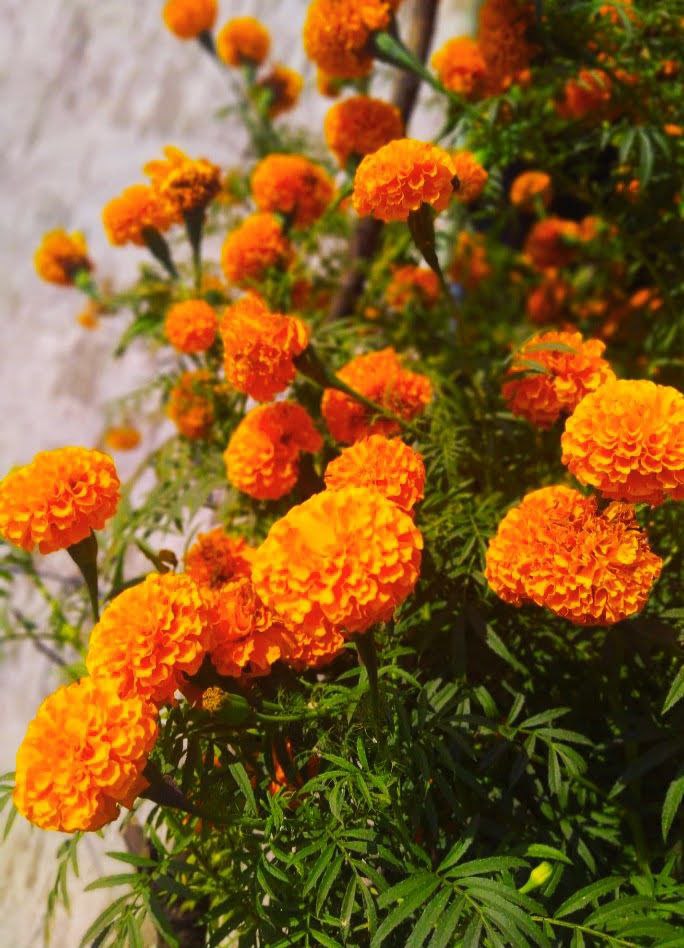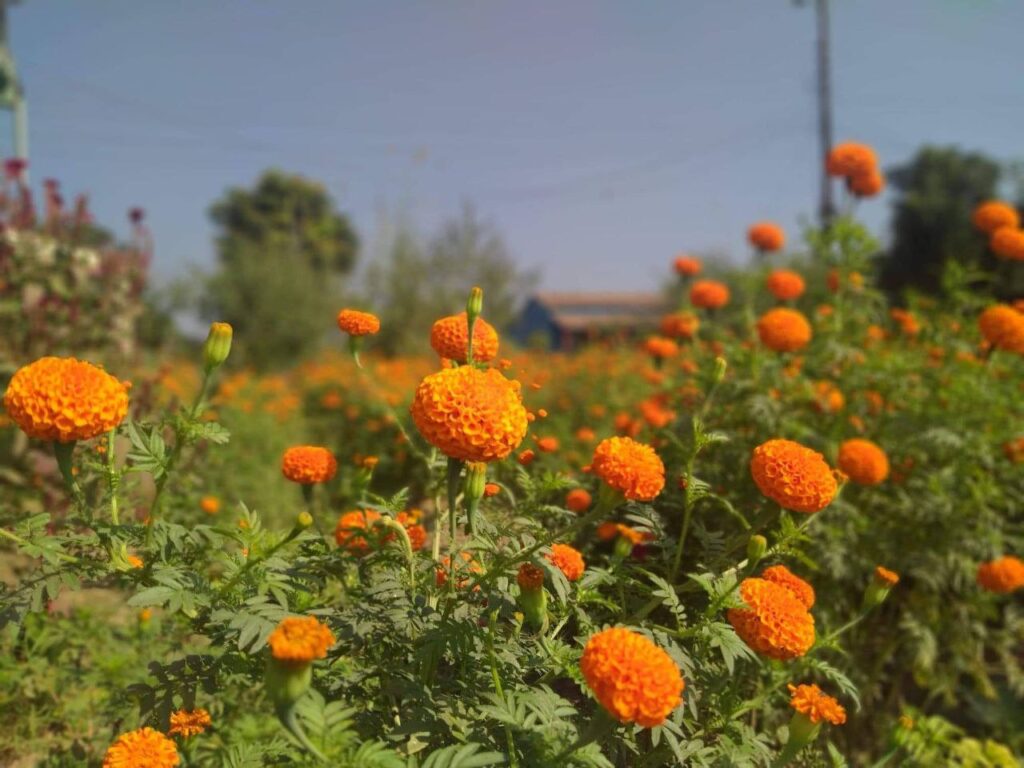Introduction
Botanical Name: Tagetes patula – French marigold
Tagetes erecta – African marigold
Family : Compositae
Origin : Central and South America and Mexico

Marigolds are one of the most popular, short-duration flowering plants, known for their vibrant orange and yellow blooms, that bring a lively charm to gardens and landscapes. They are commonly grown for their significance in various religious and cultural ceremonies. Marigolds are valued for their medicinal and culinary uses as well.
There are around 33 species of the genus Tagetes. Among these, the two species are important and suitable for commercial cultivation.
African marigold: The plant is tall and hardy. It is around 90 cm tall, erect and branched. Flowers are single to fully double and large size globular heads and color varies from lemon yellow to yellow, golden yellow or orange. It is a diploid, 2n=24.
French marigold: The plant is a dwarf (30 cm tall), and bushy. Flowers are either single or double and color varies from yellow, orange, reddish brown to bicolor. It is a tetraploid, 2n = 48.
Importance
- Marigold is extensively used as loose flowers to make garlands for religious and social functions.
- It has gained popularity amongst gardeners because of its ease of cultivation and wide adaptability.
- They can be planted in the garden beds for a striking display or grown in pots.
- The demand for Marigold flowers during festivals is very high.
- Marigold serves as an excellent source of carotenoid pigments in poultry feed, helping to intensify the yellow color of egg yolks.
- Marigolds also have industrial uses, such as in the production of natural dyes and essential oils.
- It is used as a mosquito and nematode repellent. The marigold plants are beneficial for suppressing the population of nematodes in the field.
- Marigolds produce thiophenes, which are toxic to nematodes and used as trap crops in tomato, brinjal, tobacco, etc.
- The uses of marigold are many fold, often referred to as, a “Versatile crop with golden harvest”.
- African marigold represents ‘vulgar minds’ whereas French marigold is a symbol of ‘jealousy’.

Climate
Marigold thrives in mild climates with an optimum temperature range of 20 – 30°C for luxuriant growth and flower production. Marigold plants survive best in dry and hot conditions, however, very hot climates adversely affect flower yield. Temperatures above 35°C restrict the growth of the plants, resulting in a reduction in flower size and number. In severe winter, frost causes significant damage to plants and flowers.
Soil
Marigolds can be grown in a variety of soils except in water-logged conditions. But it can be grown best on well-drained sandy loam fertile soil. Marigolds do not need more acidic or alkaline soils, pH 7.0 to 7.5 are suitable for higher flower production.
Propagation
Marigolds are commonly propagated either by seed or herbaceous cutting.
About 700-800 gm of seed is sufficient to grow Marigold in one-hectare area.
By seed:
It is widespread since seeds are readily available and germinate quickly. Seeds are typically sown in raised seedbeds, pots, or germination trays. During nursery bed preparation, 8-10 kg of well-decomposed cow dung manure per m2 of bed is thoroughly mixed with the soil.
The width of the seedbed should not exceed 1.2 meters and the height should be 15 cm. In winter, beds are often covered with a layer of straw to speed up germination. Seeds are sown thinly without overcrowding, at 2-3 cm depth. Cover the seeds with FYM or fine sand, followed by light irrigation with a rose can. The seedbed should remain moist during the entire period. Seeds take about 5-7 days for germination and become ready for transplantation in the main field after 3-4 weeks of sowing.
By cutting:
Cuttings are generally used to maintain the purity of varieties/cultivars. About 6-10 cm long cuttings are made from the apical portion of the shoot and kept for rooting. Herbaceous cuttings with one or two pairs of leaves are inserted in sand medium or soil mix in a nursery bed. Rooting is observed within 8-10 days which are later used as planting material.
Land preparation
Ploughing the field 2 to 3 times and bringing the field to a fine tilth. During the last ploughing of the field add Farm Yard Manure @ 50 tons/hectare or well-decomposed cow dung in soil.
Transplanting of seedlings
Marigold seedlings can be easily transplanted in the field with minimal loss. Transplanting should be done on well-prepared soil, ensuring that the soil around the root zone is firmly pressed to eliminate air pockets. After transplanting, light irrigation or watering with a rose can is recommended.
Spacing
Spacing should be maintained at 40×40 sq. cm or 40×30 sq. cm in African marigolds and 20× 20 sq. cm or 20 ×15 sq. cm in French marigolds.
Manure and Fertilizer
Incorporate 30-40 tons of FYM per hectare during the final ploughing of the field. In addition, the recommended N:P: K fertilizer dose of 150:80:80 kg/ha should also be applied. Half the quantity of nitrogen, full dose of potash, and phosphorus should be applied as a basal dose, while transplanting the seedlings. The remaining quantity of nitrogen should be applied two times at 30 and 60 days after transplanting. Marigold also needs micronutrients such as zinc and boron to enhance flower quality and yield.
Irrigation
Irrigation is done once a week or when necessary. Water stagnation must be prevented and a constant moisture supply should be maintained from the formation of buds to the harvesting of flowers.
Weed Control
Weeds pose a significant challenge in marigold cultivation, particularly during the rainy season. If the weeds are not removed in time, significant losses in marigold growth and productivity may result. In order to get profuse flowering; it is necessary to keep the field weed-free. During the entire growth period, around 3-4 manual weeding is required.
Pinching
The removal of apical buds is referred to as pinching. In the case of tall cultivars of African marigolds, the plant typically reaches its full height before developing axillary branches apical buds are removed at an early stage, more lateral shoots develop leading to a bushier plant bearing more uniform flowers.
Delayed transplanting can sometimes lead to the early development of flower buds. In such cases, to encourage full vegetative growth such flower buds are disbudded. Pinching is recommended after 40 days of transplanting.
Staking
This involves providing support to tall plants. African-type marigold plants grow tall and require staking with bamboo sticks to prevent lodging and bent stems, which may negatively affect the yield.
Harvesting
The time to harvest marigolds depends on the variety. French Marigolds are ready for harvest in about 1.5 months, while African Marigolds require two months.
Harvest the flowers once the plants attain their full size. Harvesting should take place during the morning or evening hours. The field should be irrigated before plucking of flowers, it will help to maintain quality for a longer period.

